Adapting to Change: Arenas Rely on Steel
Structural steel delivers the flexibility and adaptability required by today and tomorrow’s multipurpose arenas
![]() Continuing Education
Continuing Education
Use the following learning objectives to focus your study while reading this month’s Continuing Education article.
Learning Objectives - After reading this article, you will be able to:
- Summarize multipurpose arenas’ evolving needs for adaptability and flexibility to service a variety of venues.
- Discuss the benefits of structural steel roofs for arenas, including their light weight, high strength-to-weight ratio, and ability to support growing high-capacity rigging load requirements.
- List key factors that must be considered when designing a long-span arena roof.
- Review the structural design details of noteworthy steel roof retrofit projects.
In the battle for fans and audience members, today’s multipurpose arenas are boasting bigger and better scoreboards, over-the-top amenities, and unique and varied seating options to lure spectators out of their homes (and off of their smartphones) and into the arenas to watch the games, competitions, and concerts.
Arenas, as opposed to larger stadium venues, have the nimbleness to support the quick and varied changeovers required by the variety of events and attractions utilizing the spaces. However, to optimally support current and future venue needs, these arenas must have the ability to adapt and upgrade.
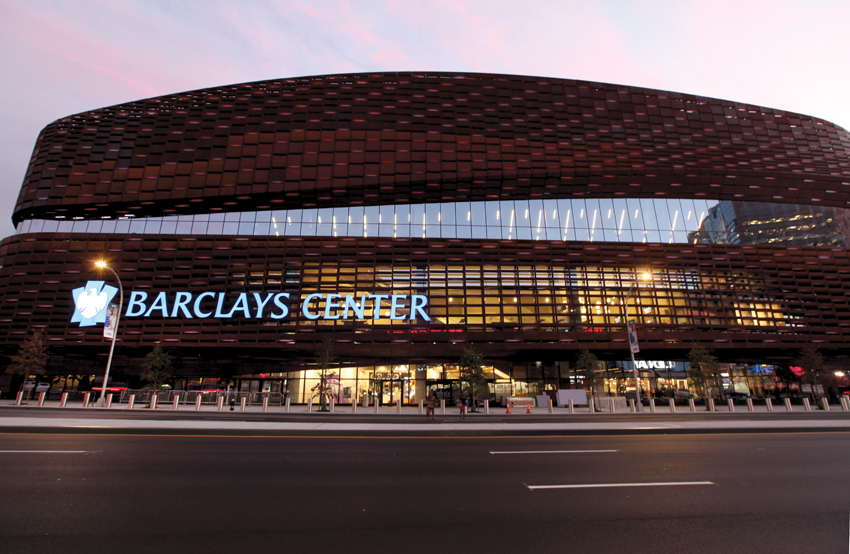
Photo courtesy of Thornton Tomasetti
With its flexibility, adaptability, high strength-to-weight ratio, and ability to support long spans, structural steel—like that used for Barclays Center in Brooklyn—is a material of choice for today’s multipurpose arenas.
One key aspect of this equation is the roof design. “The roof often comprises the largest surface area on an arena, and the vast, unobstructed program space it shelters below offers maximum flexibility for reconfiguration and reuse,” states John Cerone, principal, SHoP Architects, New York.
In fact, seating bowls and support spaces are constantly being reinvented to support trending fan behaviors, says Bart Miller, PE, principal, senior project manager, national sports market leader, Walter P. Moore, Houston. Tasked with frequent renovations, it behooves arenas to anticipate future structural support and flexibility needs from the onset.
“Effective planning and informed decision-making early in the design process can save millions in construction costs and generate millions in future revenues,” Miller explains. “Structural steel allows for the most flexibility in structural modifications, as it can be economically configured for optimal column locations and structural framing depths that allow for contiguous open spaces and increased ceiling heights, and it can be easily reinforced or removed in the future if necessary.”
In addition to sporting events, infrastructure must be built to accommodate top music performers and tours.
“Concerts are asking more of arena roof structures with each new tour by applying heavier and more numerous loads, often that move, distributed over much larger areas than ever before,” Miller reports.
High-Capacity Rigging Grids
Consequently, one of the critical design decisions for a long-span roof system is the evaluation of loading assumptions for concert rigging and scoreboards, explains Jeff Callow, PE, LEED AP, principal, Thornton Tomasetti, New York. “No one wants to have tours turn their facility away because they are limited on what they can do and hang from the roof,” he says.
As venues compete for concerts and other events, arenas that have suitable show rigging capacity, frequent and useful points to rig from, and are easy and safe to access are at a great advantage, confirms Brian A. Dickson, PE, SE, senior principal, Magnusson Klemencic Associates, Seattle.
“A clever, experienced arena roof design will integrate the catwalk provisions and rigging points seamlessly into the roof design from the outset,” adds Peter Aryes, global service leader, structural, for Aurecon, an engineering firm active in the Australian and South African market with a specialty in arenas and stadiums.
Putting things into perspective, venues designed as recently as 10–15 years ago can generally support rigging grids of up to 100,000–120,000 pounds concentrated over the center and end stages only. Now those grids are proving inadequate, as today’s heaviest arena shows—such as Kanye West, Drake, and Game of Thrones—can exceed 250,000 pounds with loads distributed widely across the entire venue roof structure.
In response, many venues are now looking to increase their rigging grid capacity and coverage, which often necessitates the addition of rigging beams and may require strengthening of their primary roof structures. “In planning a new facility, owners should consider proportioning their rigging grid to extend across the entire event floor, be configured for optimum speed and accessibility, and provide far more capacity than they think they will need,” recommends Miller. “The construction costs associated with additional capacity and coverage are nominal, making it much wiser to build it now than to retrofit later.”

Image courtesy of AMB Sports & Entertainment
Retractable roofs offer the best of both worlds—an authentic outdoor fan experience and a comfortable, temperature-controlled environment on cold, rainy, or exceptionally hot days—as shown here at Atlanta’s Mercedes-Benz Stadium.
Structural Steel Roofs
In addition to supporting high-capacity rigging loads, structural steel for long-span roof structures is arguably the “right system” for arena and event centers, asserts Dickson.
“Structural steel is familiar and readily available in nearly any market, can accommodate nearly any desired shape, and can span distances of 300 feet to 400 feet with ease,” Miller states.
Additionally, steel structures can be retrofitted by selective structural strengthening of the existing shapes and/or connections to achieve greater capacity.
As a lightweight material with a high strength-to-weight ratio, structural steel supports long spans, which is ideal for fabrication and erection. By manufacturing the members into smaller pieces, they are easier to transport and move onto the job site, where they are then attached. “The versatility of using either bolted or welded connections provides fabricators and erectors with ultimate flexibility in selecting fabrication processes and installation techniques that fit their equipment, capabilities, and often limited project schedules,” Miller explains.
Steel can also be attached to existing concrete structures, or in many cases, columns can be threaded through the existing structure to provide support for new roof elements, adds Cristobal Correa, PE, principal, structures, Buro Happold, New York.
The structural steel members can be easily modified, strengthened, or removed in the field, which is especially important for multipurpose venues with evolving functional, operational, and aesthetic requirements.
Offering some more insight into why steel is particularly suited for large spans with less distance between the columns/supports, Charis J. Gantes, Ph.D., professor of structural engineering, National Technical University of Athens, Greece, explains that as the span increases, the stresses increase proportionally to the square of the span and the deflections proportionally to the fourth power of the span—or in other words, very quickly. It then becomes very difficult to satisfy the stress/strength and deflection/serviceability constraints.
One strategy is increasing the section, but this is not very effective because then the self-weight also increases. Besides adding to cost, this also adds to the weight that the structure must sustain. Gantes explains that in large spans, the structure mostly carries itself, with little reserve left for live loads, and at a certain span length, the structure cannot even carry itself. “Therefore, for large spans, such as in arena roofs, it is effective to use materials that have high allowable stress to satisfy strength constraints and high modulus of elasticity to satisfy serviceability constraints. This makes steel the best and perhaps only choice,” he says.
This issue of minimizing the self-weight of the structure is of primary importance, emphasizes Craig Tracy, vice president, WSP, Montclair, New Jersey, as every pound of self-weight robs capacity from the structure to support external loads, such as snow, wind etc., and each square inch of structure that is added to support self-weight requires more material to support that added weight.
“The inefficiency of this structural tail-chasing is minimized by using materials that have the best strength and stiffness/modulus relative to their density,” Tracy states. “Comparing the best materials available for construction today, one finds that structural steel has a 50 percent higher specific strength and 30 percent higher specific modulus than concrete.”
Roofing Types
Long span: The majority of today’s arenas of up to 25,000 seats are long-span truss roofs. In addition to supporting video boards and concert rigging, the roof will often participate in the acoustic objectives for the facility (i.e., foster good interior sound, address sound escaping the venue, etc.),” says Dickson.
“Long-span truss roofs can support large loads close to the oculus and facilitate construction by providing a support line without the requirement for temporary works below,” states Peter Chipchase, M.Eng., C.Eng., MICE, MIStructE, PE, director, WSP, London.
Because the NBA and NHL maintain stringent temperature, humidity, and sports lighting requirements for their venues, the roofs are typically closed and fixed.
Tension/compression ring system: This is a lightweight, long-span solution that can internalize the inherent forces within itself, much like a bicycle wheel, Correa explains. “This often creates advantages for a sympathetic retrofit of an existing venue by reducing the impact on the current structure, or creating a demountable system that can be removed, replaced, or modified independently—with minimal impact on the internal program—to promote venue flexibility and help future-proof a design,” he says.
Retractable roofs: Though not typically found in arenas, retractable roofs offer the authentic experience of playing football, baseball, or soccer outdoors, while maintaining a comfortable, temperature-controlled environment on especially warm, cold, or rainy days.
“A retractable roof can provide the best of both worlds, allowing for the venue to be either an open-air or enclosed stadium depending on the weather and the preferences of the fans,” Miller says.
Buro Happold Principal Derrick Roorda, SE, points out that designs must accommodate both open and closed loading conditions and have a mechanism for opening and closing that can be accommodated by the structural system.
Cantilevered canopies: Though more common in stadiums, cantilever roofs are a signature architectural element, enhancing the fan experience with unobstructed views and creating a greater sense of intimacy in the seating bowl, according to Miller.
Offering the benefit of modularization and standardization, this enables mass production. Consequently, the project benefits from fabrication efficiencies, repetitive construction, and extensive optimization to reduce steel tonnage while maintaining performance, explains Chipchase. As self-supporting units, they can be installed on multiple work-fronts, thereby shortening the construction schedule.
Fabric roofs: Also more common in stadiums and ballparks, these lightweight tensile structures utilize membranes to enclose the primary structure. “Clear and translucent roofing and facade materials, such as ETFE and PTFE, create an outdoor atmosphere in a permanently enclosed, conditioned space,” Miller says. The lightweight roof materials reduce structural support requirements and cost.
Fabric and cable roofs are sometimes used in pure sports venues where blackout conditions, acoustic performance, and high rigging loads are less important, but Aryes would not normally recommend them for an entertainment-led, commercially driven venue. These roofing types “tend to come into their own on larger stadium projects where minimizing self-weight is even more important, climatic control is less important, and a lighter, airier structure is more architecturally attractive,” he says.
Stadium Roof Considerations
In determining which roofing system is best for a particular project, a number of factors must be taken into consideration.
“The needs of arenas and stadiums and environmental effects (such as rain, wind, snow, and ambient temperature) as well as the future readiness of the venue weigh heavily on the selection of the appropriate long-span roof: fixed closed roof, partially closed roof, or retractable roof,” explains Cerone.
Additional factors for determining the ideal solution for a long-span roof, according to Miller, include geometric alignment with architectural design intent, structural efficiency that minimizes materials and self-weight, repetition in detailing and assembly, ease and speed of erection, the capacity, expertise and competitiveness of local contractors, fabricators, and erectors, and site considerations, such as crane access and removal.
While weighing these factors will help guide the design decision, there is no single formula that always yields the best solution.
Offering some general guidance on typical arena configurations, Aryes relates that most modern commercially driven arenas have roofs with a primary span in the range of 100–130 meters (325–425 feet) with an aspect ratio of around 1.2–1.5. “They require a fairly dense node configuration to accommodate rigging, and they tend to be blacked out,” he explains. “As a result, they almost always end up being some form of one-way truss, two-way truss, or space frame configuration since these options tend to favor relatively low roof profiles and are relatively easy to build using easily handleable components.”
When Aryes’ team embarks upon a long-span roof project, one of the first questions it asks is what the roof will look like once it is half built since the cost of erection and temporary works can easily outweigh the material costs. Unlike some roof types that are only stable once complete, the benefit of trussed roofs is that they can be assembled in robust, stable, handleable components and tend to be self-stabilizing with minimal temporary works. Consequently, the roof construction does not paralyze the entire site in the way that a dome or cable-net roof might.
Another major consideration is the roof’s ability to support future flexibility and retrofits. As market needs are constantly changing, arena owners are looking to maximize the flexibility of their venues. For example, the infrastructure required for network broadcasting is quickly evolving and needs frequent updating. “Revenue models evolve as well, requiring the rebalancing of fixed seating, suites, concessions, and other spectator experiences,” adds Tracy.
That said, steel structures generally add the most flexibility when it comes to renovations. For example, demolition can usually be achieved using cutting torches, diamond saws, and other small tools, Tracy explains. And connections to the existing structure can be made through welding and bolting, which are both methods that can be reliably inspected and afford a high level of confidence.
At the same time, it is not as common to retrofit the long-span roof structure itself because accessing the trusses to perform structural work is exponentially more expensive once the facility is opened; the work is highly field intensive, and room for logistics is limited at that point, says Callow. Consequently, it is important for the project team to carefully evaluate the desired allowances for show rigging and potential scoreboard upsizing to strike a balance between minimizing future retrofit work and day-one construction cost.
Barclays Center
Taking a look at the way structural steel was designed and fabricated for a high-profile multipurpose arena project, Brooklyn’s Barclays Center, designed by AECOM and SHoP Architects, is home to the National Basketball Association’s (NBA’s) Brooklyn Nets and one of the home arenas for the National Hockey League’s (NHL’s) New York Islanders, in addition to a host for concerts, conventions, and other sporting and entertainment events.

Photo courtesy of Forest City Rater Companies
A 350-foot long-span structural steel roof crowns Barclays Center in Brooklyn.
The building design was heavily influenced by the Bankers Life Fieldhouse in Indianapolis, which is rated as one of the premier basketball viewing facilities in the country, and provides excellent sightlines, as the roof structure is much higher than the seating, explains Callow, whose firm did the structural engineering for the project.
But one noted difference between the two arenas is that Bankers Life was a concrete superstructure with a conventional arched truss, whereas Barclays Center was more suited for a steel superstructure and a tied-arch system. This determination was based on initial schedule and cost studies that showed the tied-arch system was an efficient way to achieve the 350-foot roof span.
Working on a congested urban site, the choice of steel also eliminated the potential scheduling challenges of having too many trades on location at one time. On the other hand, with limited real estate for on-site building, the steel structure did not inherently have sufficient lateral stiffness to resist the arch thrust forces alone. The solution was introducing a tension tie to balance the arch forces. Consequently, the thrust forces imposed on the superstructure are greatly minimized.
“This strategy also simplified the overall roof system, as two ‘super’ tied-arch trusses were provided to span the long direction of the arena, while shallow trusses span between the super trusses and the perimeter,” explains Callow. “With the pure arch trusses, it was preferable to distribute that thrust across the whole building, whereas the self-contained load path of the tied arch trusses allowed them to be centralized.”
Several analytical studies were performed to both understand and design for some component of the overall thrust that results due to the stiffness of the building, he adds. Construction sequencing with member leave-outs were performed to minimize the amount of the thrust that ‘leaked’ to the primary structure to maximize the superstructure’s efficiency.
Two main tied-arch trusses run in the long east-west direction, spanning approximately 350 feet. Each comprises a 12-foot-6-inch-deep arched upper truss, with chords made up of W14s that vary across the section and a tension tie, consisting of a 14x311 wide-flange member, which occurs approximately 50 feet below the top of the arched truss and 10 feet above the lower ends of the truss for optimized sight-line preservation. The truss configuration was largely dictated by the fabricator’s shipping limitations. The tie is hung by a series of eight, 8-inch vertical HSF pipes. Sixteen smaller trusses connect with the large longitudinal trusses and provide the free span of the arena with chord sizes varying from 14x90 to 14x159. Dead loads and lateral loads are resolved into the steel superstructure, with thrust forces from the trusses largely balanced by the ties.
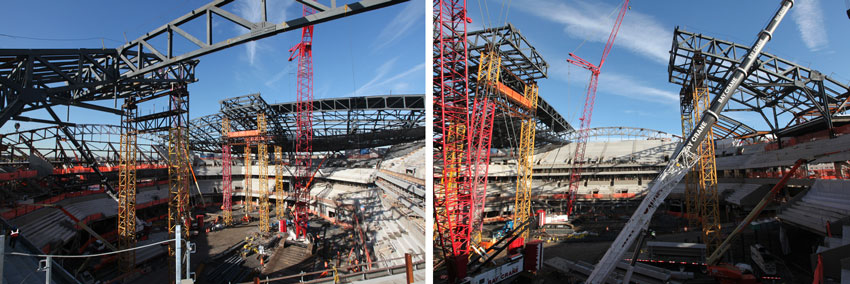
Photos courtesy of Thornton Tomasetti
Pictured here is the erection of primary roof trusses at Barclay Center. Four temporary shoring towers were provided to allow for construction of the tied arch truss elements.
Callow explains that one of the project’s main structural challenges was connecting the tied arch to the steel superstructure that rings Barclays Center and forms its street-side concourse. In a conventional design, where the tension tie would connect at the ends of the truss, the truss would rest on a roller or bearing support that could allow the truss some movement. However, for Barclays Center, the connection had to be able to transmit some lateral forces to the superstructure. While the introduction of the tension tie significantly reduces the amount of thrust imposed on the superstructure, it does not eliminate it completely due to strain compatibility between the tension tie elongation and the superstructure lateral displacement. To minimize this effect, Thornton Tomasetti specified a construction sequence involving leave-outs of elements to disengage the arch thrust resistance of the superstructure for de-shoring of the roof structure. This forced the tied-arch action to resist the initial dead load. After the roof was de-shored, these leave-out connections were completed, leaving the superstructure to resist thrust forces under future environmental and live load conditions.
Another unique aspect of the design is its cantilevered canopy. To find the balance between the desired geometry and project budget, Thornton Tomasetti and SHoP Architects performed numerous parametric studies. “To create the 85-foot cantilever, backspan trusses were run from the entry structure storefront all the way back to the primary bowl support columns,” explains Callow. “The three-story entry structure to the west of the primary bowl was lightly loaded, and thus it was desired to tie the cantilever backspan back to the heavier bowl structure, like the back anchorage of a diving board.”
Coordinating the cladding attachments to the cantilevered structure was one of the more challenging aspects. To address this, Callow’s team communicated anticipated movements of the cantilever under dead load, snow, thermal, and wind loads to the facade subcontractor to ensure their joints were able to accommodate the movements. The structure was pre-cambered to accommodate some of the anticipated vertical deflection. In addition, three-dimensional models of the anticipated structural range of positions during cladding panel installation was provided to the cladding manufacturer to ensure they had sufficient range of tolerance in attachment points.
“One of the less obvious benefits of the canopy structure was that the creation of the back span trusses that were needed to support the cantilever allowed for elimination of columns in the entry structure VIP restaurant region, as the back span truss was able to span over the region,” says Callow.
Barclays Center Green Roof
The second chapter of the Barclays Center story is the arena’s 135,000-square-foot green roof addition, also designed by AECOM an SHoP Architects.
“The green roof addition served a dual purpose by providing a visual amenity to the inhabitants of the surrounding new residential construction and a means of improving the acoustic performance to minimize sound transmission outside of the arena,” explains Callow.
To achieve acoustical performance targets, the green roof needed to be separated from the main roof structure by an air gap, which also provided the ideal space to locate new structural elements. While the original structural foundations were designed to support the load of a green roof, this was not the case for most of the superstructure, including the long-span roof.
To minimize penetrations to the existing roof and retrofit work to the side trusses spanning between tied arches that would be difficult to access above the bowl, new trusses were introduced in the air gap space above the current roof to span from the existing tied arches to the perimeter of the building, according to Callow.
ach arch was retrofitted with two 33⁄4-inch-diameter, 300-foot-long steel cables, the type and size more commonly used in bridge construction. The cables were pretensioned to relieve some of the load in the existing tie and provide the entire system with more axial capacity. To connect the cables and transfer the load into the existing structure, new 3-inch-thick cable gusset assemblies were welded to each side of the existing 3-inch-thick arch node.
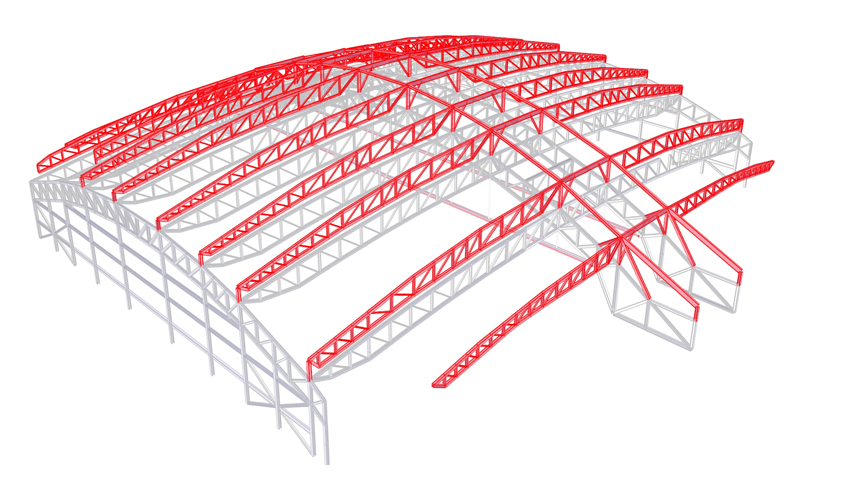
Image courtesy of Thornton Tomasetti
Supplementary steel trusses are installed above the existing roof to increase the capacity to create the Barclays Center green roof.
A new arch-shaped top chord was also posted up from the existing tied arches to increase the overall depth of the tied arch system and subsequently improve its load-carrying capacity. This additional chord is 14 feet above the existing arch chord and is tied into the existing arches with a vertical element at each major panel point and diagonal a bracing elements at the ends of the span. In doing so, the effective depth of the arch under live loads and the weight of the new roof increased from 50–64 feet, with a proportionate decrease in member stresses.
In addition to the new elements that were constructed over the existing roof, the existing tension tie was reinforced with a pair of cables on each side of it to increase the tensile capacity of the tie.
To address the erection challenges inherent in transporting the large truss members for installation, ASTM A913 Grade 65 steel was used to reduce their weight. Mid-span shoring posts supported on the existing roof trusses below allowed each of the 170-foot secondary trusses to be erected in two segments with weights under the limiting pick capacity of each crane. Lightweight joists were used to provide infill framing, further reducing the weight of the overall structure and increasing the speed of erection.
Ultimately, a highly integrated building team succeeded in performing green roof retrofit with minimal impact to the arena’s busy event schedule.
Nassau Veterans Memorial Coliseum
The Nassau Veterans Memorial Coliseum in Uniondale, New York, a 416,000- square-foot, multipurpose arena best known for hosting NHL New York Islander and American Basketball Association New York Nets games, was recently reclad with approximately 4,700 unique aluminum fins, a move that breathed new life into the 1970s facility.
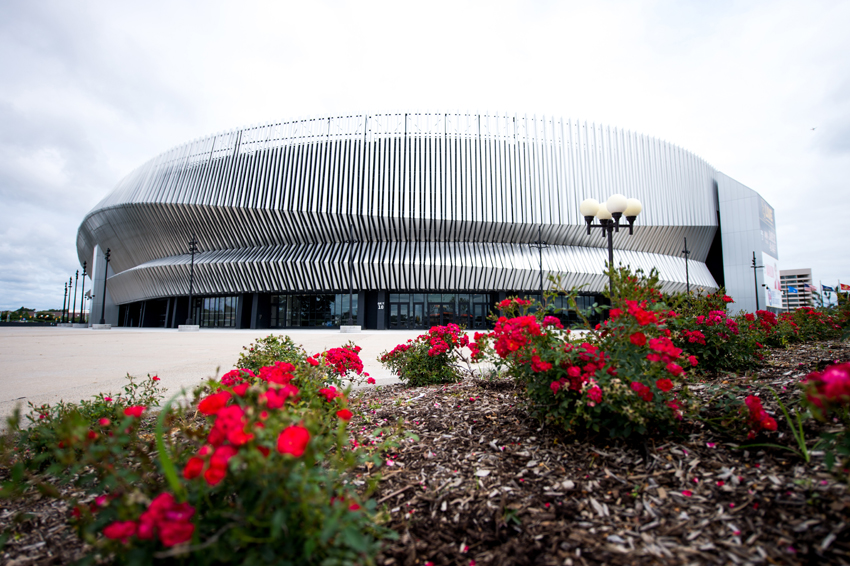
Photo: Jamey Price Photography; courtesy of 3A Composites USA
Breathing new life into the Nassau Veterans Memorial Coliseum in Uniondale, New York, approximately 4,700 unique aluminum fins were used to reclad the 416,000-square-foot facility. The canopy cantilevers approximately 85 feet from the primary building and features an open-air oculus in the center with large curved video boards.
“Each of the elements in this system varies slightly in profile and dimension to create a subtle flow that reflects the big skies of the flat Long Island landscape,” states SHoP Architects, the project’s architect, in a description of the project.
Instead of tearing down and rebuilding the facility, the project successfully met the Coliseum’s needs to provide a state-of-the-art, regularly used venue at a fraction of the budget.
A highly integrated building team essentially put their heads together to come up with an efficient and effective way to marry the building enclosure’s new shape and a new form without forcing that design upon the structure.
One major issue was how to attach the cladding. The initial schematic design employed steel structural channels, but this would have involved going behind the existing concrete siding. Building enclosure subcontractor Crown Corr then proposed a space-frame construction approach. Not only did this circumvent the risk and cost of penetrating the arena, but it embellished SHoP Architects’ vision for a reinvented skin.
“Instead of channels and angles installed behind the fins, now there would be tubes and space-frame nodes,” relates Cerone. At the same time, SHoP Architects needed to understand the aesthetic implications of this change. Fortunately, it was easy to model the change and the architects were happy with the results. More specifically, the architect utilized a high-fidelity digital process, leveraging LiDAR scanning to survey and model existing conditions, to which design models were tailored, coordinated, and evolved into fabrication. “Structural steel aided the process due to the accuracy of fabrication tolerances,” he adds.
Going into more detail about this innovative attachment approach, Thornton Tomasetti’s Callow explains that the existing building had 32 radial perimeter concrete columns shaped like a U. “Through coordination with SHoP Architects and Crown Corr, we developed a detail where a short horizontal steel member would be connected between the two stems of the U-shaped column. By utilizing the cavity, we were able to connect the member to the existing concrete column using a shear transfer rather than a direct face mounted tension connection.”

Photo courtesy of Thornton Tomasetti
Nassau Veterans Memorial Coliseum’s new facade panels contain a secondary steel backup system that spans to existing building columns.
Crown Corr then connected their secondary steel elements directly to this new member.
“Two anchors on the top and bottom of each of the 32 piers from which the structural steel space frame allows long spans—approximately 45 feet—support all additional secondary structure and finish cladding,” adds Cerone.
A wide-flange horizontal beam spanning the inner faces of the U-shaped pier holds the outrigger supports that intricately fits the aluminum cladding fins in the prefabricated metal space frame and attached it to the existing structure. Crown Corr’s structural lug comprises a W14x132 flange spanning 4-foot-wide welded end plates, which are bolted and epoxied to the concrete. Welded to the face of the W-flange are two match plates, from which 10-inch-diameter HSS tube frames provide welded ‘half-nodes’ for attaching adjacent space-frame panels. The attachment points are separated by approximately 9.5 feet of elevation. The space frame was assembled from HSS in diameters that vary from 2.375–3.5 inches according to tuned-to contextual loads and load paths. The chords were threaded into spherical nodes ranging from 3.5–7 inches in diameter.
The aluminum cladding material itself offered a high level of flexibility and was therefore easy to form into precise shapes. This, coupled with the cladding’s natural brushed finish, enabled SHoP Architects to create the aesthetic effect it was seeking.
“The aluminum finish picks up the ambient light and color well during different times of day and reflects the sky and sunset,” Cerone explains. “As the crowd moves into the Coliseum, colors from their clothes and the surrounding trees also get reflected into the material.”
The project’s main challenge was the juxtaposition of the existing structure’s regular geometry with the new facade’s undulating surface, which required the new structural elements to take the form of the new shape and transfer its load back to the existing column grid. “The ability of steel to span the large distances between the existing concrete columns with a lightweight structure was critical to minimizing the cost to the reclad and minimized the load imposed on the existing building,” Callow explains.
Mercedes-Benz Stadium
Opened in 2017, Atlanta’s Mercedes-Benz Stadium designed by HOK features a pinwheel-style retractable roof—an architectural gesture inspired by the oculus in the roof of Rome’s Pantheon—made possible by an intricate and highly integrated feat of engineering.
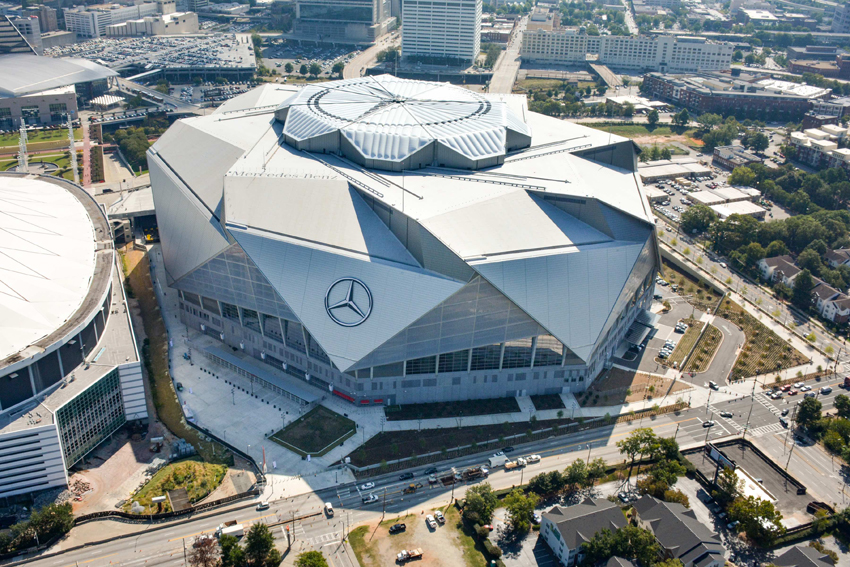
Photo courtesy of AMB Sports & Entertainment
Atlanta’s Mercedes-Benz Stadium features a highly intricate pinwheel-style retractable roof, a unique two-way spanning truss system, and single-skin ETFE facade panels.
Made from facade panels clad in single-skin ETFE (ethylene tetrafluoroethylene), the transparent, inflated lightweight material exerts minimal weight on the eight long-span cantilevered moving petals, which open and close in under 10 minutes.
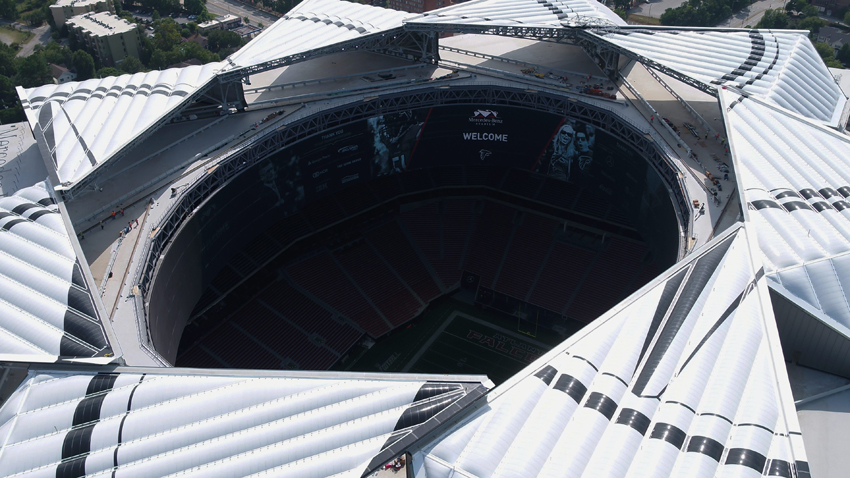
Photo courtesy of AMB Sports & Entertainment
Mercedes-Benz Stadium’s unique roof features eight long-span cantilevered moving petals that can open or close in under 10 minutes.
As stated in a Buro Happold blog, as the structural engineer on this massive, $1.6-billion project, “the complex geometry of the facades, framed with elegant lightweight steel, help to create an iconic exterior.”
The uniquely designed roof incorporates a two-way spanning truss system, which is unusual for a long-span roof. According to Yasmin Rehmanjee, PE, SE, LEED AP, principal, Buro Happold, New York, each truss is 70 feet deep and reframed with a 12-foot-square top chord truss box consisting of four chord members, with the tension chord 58 feet below. “The roof structure is framed with four primary trusses that span 723 feet and provide support to the downward force from the cantilevered, moveable panels,” she says.
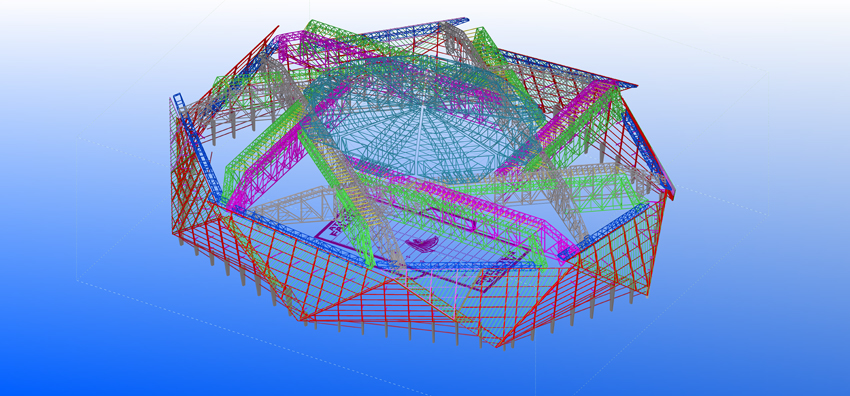
Image courtesy of Buro Happold
This structural steel Tekla model consists of about 70-foot-deep trusses with 12-foot top chord box trusses comprising four chord members, with the tension chord 58 feet below. Four primary trusses span 723 feet to support the entire fixed roof as well as the cantilevered, moveable panels.
In addition, secondary trusses support the uplift rails for the moving petals. Both 65-ksi and 50-ksi steel were used, which included the newest available jumbo shapes (W14×873) at the time.
From the project’s onset, the design team set out to conceive an unprecedented operable roof—using more moving pieces and smaller spans with the intention of creating an opening that operates faster than any other retractable roof in an eye-catching manner.
“Despite giving a visual effect similar to a camera shutter when opening, each of the petals moves along straight tracks on the fixed roof,” Rehmanjee explains. “Constant and in-depth information exchange is required between the structural engineer and the mechanization contractor to ensure that the mechanization is capable of handling the loads imposed by the moveable panels.”
In describing the intricate engineering that went into achieving this, Bill Darden, president of Darden & Company, the project management firm overseeing development of the stadium, compared the construction to a Swiss watchmaker working with micro-ounce pieces that are so small you can barely even know they are in your hand, with one major difference. In this case, “there are 4,000 tons of steel in these eight petals, and we are trying to accomplish the same exact thing because these pieces have to move at the exact precise time and must have very tight tolerances between the bogies and rails. It is very precise…we are literally talking about 1⁄16 and 1⁄32 of an inch,” explains Darden in an interview with the Atlantic Journal-Constitution.
In addition to the challenge of supporting eight moving roof panels, the roof trusses had to be placed in such a way as to not block the roof opening but rather frame the 60-foot-tall halo video board at the stadium.
The board itself is quite remarkable. Called the Halo Board, it is a 360-degree, 58-foot-tall, high-definition LED video display delivering an immersive and theatrical experience whether the roof is open or closed.
To create this impressive new stadium with its 72,000 seats, 18,000 tons of structural steel was used for the fixed roof, 4,000 tons went into the retractable portion, another 4,000 tons make up the ‘skin’ of the building, and 580 tons support the video board.
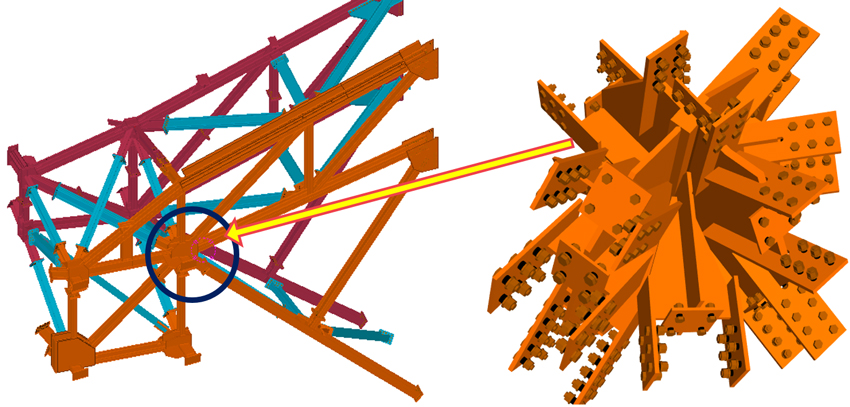
Image courtesy of Buro Happold
This 3-D image shows a connection detail of the complex steel nodes for trusses in which several members frame into a single location. The Mercedes-Benz Stadium roof structure includes both 65-ksi and 50-ksi steel, as well as the newest jumbo shapes at the time, W14×873.
Rehmanjee describes the importance of understanding how the structure will be built while correctly accounting for the forces that get locked into the structure during construction—a crucial part of the project delivery process. One part of this equation is the structural engineer making an assumption about construction sequence, which must be communicated to key contractors when they come on board. In the case that the contractor changes the construction sequence to suit their preference, it is of utmost importance that the roof design is reevaluated for the revised sequence to ensure that the members and connections are still capable of resisting any changes to load demand.
On the Horizon
Whether it is more iconic elements, large retractable roofs, mega-size scoreboards, or large-scale operable windows, future arenas will demand bigger, better, and more advanced facilities than ever before.
And as arenas seek to create more unique experiences, designers will be challenged to find that balance between flexibility and authenticity, or as Miller explains, “conceiving a facility that can easily accommodate any event but also provide a custom-designed, event-specific experience for every fan.”
To address the challenges that lie ahead, Callow believes that structural steel is well served to achieve the high strength, light weight, and ability to fabricate to form unique geometries that will be demanded. Staying a step ahead of the game, Thornton Tomasetti has started creating and integrating fabricator-ready Tekla (a popular BIM software program well suited for structural design) models into its design process for sports projects constructed with steel. “By doing this, we not only can help owners achieve faster schedules, but we can also work through the complicated geometry using parametric tools and develop connections in lock-step with the architect to achieve more dramatic forms,” he explains.
Callow adds that the firm has already been utilizing high-strength 65-ksi steel on numerous long-span projects and anticipates that higher strengths are on the way, particularly with bolted fasteners that may further enhance the efficiency of tomorrow’s structures.
Correa agrees that the high strength and low weight of structural steel makes it the material of choice for long-spanned roofs and cantilevers. “As stadium design evolves to create spaces that are destinations unto themselves, there is increased need to create spectacular design and inviting spaces. In addition, it is becoming more and more prevalent to build arenas and stadiums that can accommodate several weather conditions, and this is done by transparent roofs that open or walls that slide. Structural steel supports these design aspirations well.”
Again, the ultimate goal is gaining the flexibility to be able to operate in a variety of event modes. “With the right brief at the outset, it is possible to design an efficient structure in steel that can accommodate flexibility in spectator requirements and behavior, and different event loading patterns,” says WSP’s Chipchase. “They can also be designed and detailed to facilitate permanent conversion by way of removal, addition, or modification to the primary structure to transform following a major event, for example, where the brief and requirements fundamentally change.”
One other emerging trend is what Aryes describes as entertainment-focused, immersive super theatres. While he cannot specify “where this will take us,” one thing he is sure of is that the inherent benefits of steel will make it the material of choice for long-span arena structures of all shapes and sizes for many years to come.
Barbara Horwitz-Bennett is a veteran architectural journalist who has written hundreds of CEUs and articles for various AEC publications. www.bhbennett.com
